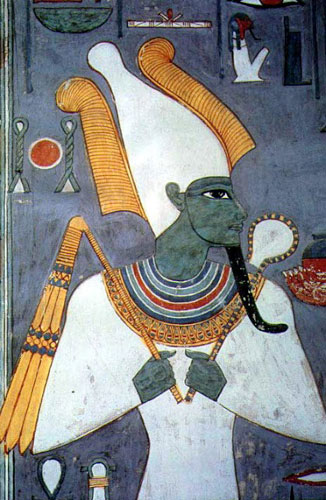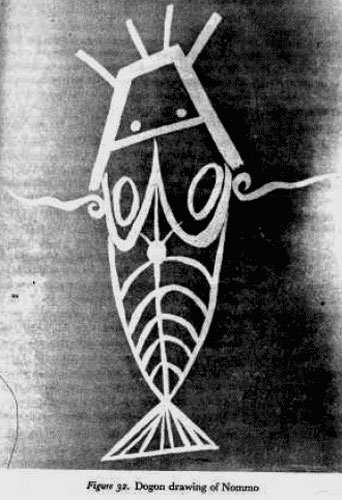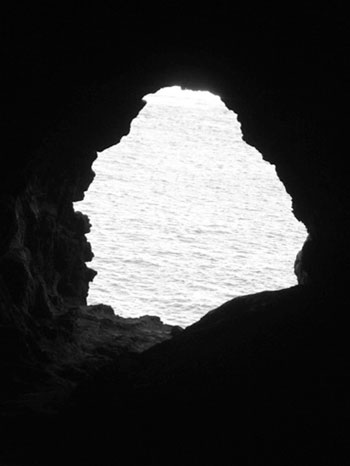ITERATION 1: QUETZALCOATL—MY ANGEL!
FRAME 1
Cross-fade of jaguar with Canary Wharf pyramid by night.
FRAME 2
Flickering multi-colored monochromatic text on black
ABOLISH THE LABYRINTH
FRAME 3
Reclining female astronaut on monochrome backdrop with images projected on glass of helmet. (Mechanical)
The old sense of alienation is no longer possible. When individuals identify with a lifestyle imposed on them, and through it experience gratification and satisfaction, their alienation is subsumed by their own alienated existence.
Early esoteric or hermetic thought contends that the visible world is no more than a projection of consciousness, a hologram if you will, and has no more substance than air. In fact it is through piercing the rent in this veil of consciousness that we start to perceive the true structure of things. This idea of the hologram is often referred to by Robert Anton Wilson, and forms the basis of much of the late fiction of Philip K. Dick (subsequent to his own Gnostic epiphany). Parallels also exist in the 10,000 things of Daoist thought, which are the myriad distractions of the material world.
Green/blue-skinned gods occur in various contexts in antiquity, from Osiris, god of the afterlife in Ancient Egypt, to Krishna in Hindu mythology and Quetzalcoatl in Aztec cosmology. Robert Anton Wilson in his Schrodinger’s Cat Trilogy (New York: Dell, 1979, p. 526) playfully combines ideas of future-past with conspiracies relating to alien visitors at the dawn of humanity (and racial theories to boot):
A brutal group of Cro-Magnons came over the hill and began clubbing Ancient Astronauts to death. The Cro-Magnons were tall, blond, and Aryan; the Astronauts had the blue skin of Krishna and Quetzalcoatl.

FRAME 4
INT. FLOTATION TANK IN EMPTY “DESIGNER” ROOM. (IMPRESSION OF BEING WITHIN CANARY WHARF PYRAMID.)
Whale noise comes through voice-over.
The Dogon people, believed to be of Egyptian descent, lived in Libya for a time before settling in Mali, Western Africa, bringing with them astronomical knowledge dating back to before 3200 BCE. They believe this knowledge was given to them by the Nommos, advanced amphibious beings from the star Sirius:
The Nommo divided his body among men to feed them; that is why it is also said that as the universe had drunk of his body, the Nommo also made men drink. He gave all his life principles to human beings.
The Nommo was crucified and resurrected and in the future will again visit the earth, this time in human form. Later he will assume his amphibious form and will rule the world from the waters.
Particularly curious about the astronomical awareness given them by the Nommos is the fact that it contains centuries-old knowledge of the existence, character, and trajectory of the white dwarf star Sirius B, which is so difficult to observe, even with a telescope, that the first photograph of it was only taken in 1970. In addition, they were also aware of Saturn’s rings, Jupiter’s four major moons, and the fact that the planets revolve around the Sun, rather than vice versa, centuries before modern science “discovered” these facts.

FRAME 5
Stills of cruise liner with white flash cuts
FRAME 6
EXT. MAYAN TEMPLE
In December 2011 I travelled to the Caribbean coast of Mexico with what I term a "prepared" 16mm camera. By blocking the spools you get a "dragged" image as below. Although you can never be certain of the results, I was open to how it might provide an alien POV-thinking of the flashback sequences in The Man Who Fell to Earth.
FRAME 7
Flash—flame—cut
FRAME 8 (V.O.)
Sea as pyramid
At the small dock of X lay beached the giant cruise liner …
FRAME 9 (V.O.)
… disgorging its cargo of human carrion. Venturing ever …
Flashing text
LEVIATHAN
FRAME 10
Lemon rind in seaweed as visual metaphor for carrion and continuation of “yellow” as signifier.
Carrion, or roadkill, as well as being an important part of a healthy diet for a number of carnivores and omnivores, is fast becoming the subject of economical or low-impact human diets in an uncertain future. Additionally, it operates as an alternative to processed meat and the widespread use of steroids and other additives. It is also a useful metaphor for our own uncertain future, if we remain at a lower level of awareness and do not see beyond the veil of appearances.
FRAME 10 (V.O.)
… further in their viral penetration of the osmotic …
FRAME 11 (V.O.)
EXT. COAST
… divide between phalanx: non-phalanx, repeating and reproducing their superior insect strain …
FRAME 12 (V.O.)
Two figures emerge from the sea
… by blending with the locals and strewing their debris like droppings for flies …
October 2013: Pre-production workshop with choreographer Salima Moumni (Les Pieds Nus), on location in Sidi Ifni, looking for a way of activating body and site in relation to one another. What if the body contains the landscape? And how to manifest via the body a choreography of sea and sand—what are the elemental properties proper to each element? And how do they confront each other when they meet? These and other questions were proposed at an event held at Witte de With (25/7/2013) to discuss the project, under the title, “How can violence function as an act of resistance?”
FRAME 13
EXT. JUNGLE
FRAME 14
EXT. CLIFFS
FRAME 15
Two astronauts
Ancient Astronaut Theory—often associated with controversial Norwegian writer Erich Von Daniken, author of the bestseller Chariots of the Gods (1968)—looks at traces of visits by beings from other planets at pivotal moments in human history and civilization, including the Maya and the Renaissance. Doris Lessing explores similar themes in her quintet of novels collected under the umbrella title Canopus in Argos, and begun with Shikasta (1979), although claiming greater influence from mystical tropes in Sufism, and in particular the writings of Idries Shah.
FRAME 16 (V.O.)
Footprints in the sand
I walked on when the footsteps grew fainter
FRAME 17 (V.O.)
EXT. CLIFFS AND BEACH
I had a curious feeling that I was living on
several planes simultaneously; the overlapping of these
planes was confusing …
At a round-table discussion that Omar Berrada and I had initiated at Dar Al Mamun in February 2013, Morad Montazami suggested channeling Jean Rouch’s animist camera within the film as a way of bringing the landscape to bear as a protagonist in and of itself. This image is a test on location using a Multivision filter to try and find one or more ways to do this.
FRAME 18 (V.O.)
Close-up of one of the astronaut’s faces encased in a helmet.
… Huge rounded boulders as big as houses, [pause]
Frame 19 (V.O.)
Close-up of a caveman’s face
… resembling the heads of decapitated giants, were
lying near …
FRAME 20 (V.O.)
Geometric promenade with ghost ship in distance (barely moving locked off shot).
… where they had fallen long ago from the mountainside.
FRAME 21
Cave people gather at top of rock formation holding wooden and stone clubs.
The atlatl, or throwing spear, of the ancient peoples of the American Southwest represented a major technological development, allowing for greater accuracy and force in the deployment of a projectile, with less effort. In thinking of the possible weaponry to be carried by the cave people or hunter-gatherers of the piece, this and the Inuits’ harpoon with line of the seem like possible items that might have been constructed from driftwood and may have stone arrowheads or possibly metalwork, depending on what time period I wish to suggest.
FRAME 22 (V.O.)
EXT. SUFI SHRINE GHOSTING INTO MAYAN PYRAMID …
(flashing bursts 2-3 seconds)
Music, as paradoxical as it might seem …
I’m interested in this idea of both music and film as scores, which also measure the transition of time (daylight), and therefore turn about the axis of the world. In this there is a relationship to Sufi and Islamic practices of circumambulation:
“And He made dark its night and brought out the light of its morning.”
(Qur’an: Surat An-Nazi’at, Verse 29)
FRAME 23 (V.O.)
EXT. MAYAN SCULPTURES
… is the result of thought. It is thought perfected …
FRAME 24 (V.O.)
Cavemen spot the aliens and move towards them.
… at its most empirical, i.e. as attitude, or stance. Thought is largely conditioned by …
For me there is a correspondence between this work and Pierre Clastres’s controversial statement regarding indigenousness/non-indigenousness in Archaeology of Violence (Los Angeles: Semiotexte, 2010 [1980], p.63):
But it is not the Yanomami who desecrate boulders this way; they do not know how to work with rock. From time to time, they will find a polished hatchet in the forest or at the river’s edge, and think it is the work of the spirits of the sky. They will use it to crush ebena seeds against the bottom of a clay pot. Who were these patient polishers? We do not know. In any case, they were former occupants of current Yanomami territory and have disappeared, probably centuries ago. All that remains are the traces of their labor, scattered throughout the region.
Re-reading Clastres, and thinking of both Ancient Astronaut Theory and quantum mechanics, has led me to rethink the cave people who appear in the script. What if they come not from humanity’s distant past, but from humanity’s future, where low-impact hunter-gatherer lifestyles have been adopted as being more sustainable?
FRAME 25 (V.O.)
Sun, flare, and reflection of thoughtful caveman in helmet
… reference, or speculation against references which …
FRAME 26 (V.O.)
The caveman attacks (nude descending staircase … slow-mo-like photogram)
… are largely arbitrary.
I have always found it interesting that Duchamp’s nudes descending staircases pre-date Boccioni’s Unique Forms of Continuity in Space by only a year. As both seem to deal with the expansion or simultaneity of the body in space, there is an interesting parallel with the development of quantum mechanics by Max Planck (who went on to win the Nobel Prize in 1918) and Albert Einstein. And perhaps more importantly, Erwin Schrodinger would not publish what became known as the Schrodinger Equation (although first developed in 1922) until 1926, articulating wave mechanics and the possibility of a particle extending in space but operating independent of time.
FRAME 27
Overlay of bat on Mayan pool structure—draining of blood = Night.
(Black and White?) (Moon)
FRAME 28
EXT. THE IMPLACABLE SOLAR LORD
Astronaut kneels on cliff edge cradling the body of other astronaut
Camera pans around into extreme close-up
Rock Carving of the Solar Lord (sun as divinity) in the Yagour Plateau of the High Atlas Mountains, Morocco. Rock carvings on the plateau date back up to 8,000 years, and have been used as a source for the Tifinagh script, which after much debate was recently adopted as the written form of the Berber dialect Tamazight—now an official state language of Morocco. In an interesting twist, Tifinagh was adopted ahead of Arabic or Latin script, even though it has been out of common use for approximately 1,000 years. The entire dialogue for the film will be spoken in Tamazight, and then it will appear in various translations depending on where it is being presented. It is worth noting that Tamazight is one of six main Berber dialects, but is increasingly being adopted as a standardized form (not without its advocates and opponents).
Famous Berbers through the ages include: Saint Augustine of Hippo, the medieval explorer Ibn Batutta, and contemporary footballer Zinedine Zidane.
Tamazight/Tifinagh symbol representing the letter “z” but also “freedom,” and used by the Kabyle (another dialect of Berber) liberation movement in the Maghreb. The etymology of Tamazight (the Berber language) derives from Amazigh: “a Berber,” plural: i-Mazigh-en, meaning : “free people” or “free and noble men,” and has its parallel with the ancient Greco-Roman name for the Beber people: “Mazices.”
FRAME 29
Gap in time (section through cave)
This is an image I took on a research trip to Easter Island in 2010. It was also a working “drawing” for the idea of animism and the cult of the grotto, which occurs in both Morocco and Easter Island. Thor Heyerdahl, in his book: Aku-Aku: The Secret of Easter Island (1958), speaks of myths relating to guardian spirits of sacred family caves. A similar strain of animism persists from pre-Islamic Berber culture in terms of sacred spirits inhabiting caves in Morocco (cf. Henri Basset, Le Culte des Grottes au Maroc, Editions Carbonel, 1920). Like the eighteenth-century “Baron D’Harcanville” before him, Heyerdahl also hypothesized a transatlantic link between Egypt and Central America.

FRAME 30
Suburban swimming pool—implicit structural critique
Will the suburban swimming pool, much like the golf course in its excess water consumption and private access, become a totem of excess consumption and the inequity of resource distribution—as well as representing the diminishment of communal activity and shared space?
FRAME 31
FIN
TEXT/AUTHORS
FRAME 2:
Alfred Bester, The Demolished Man
FRAME 3:
Herbert Marcuse, One-Dimensional Man (quoted in Marco Ferreri’s Dillinger is Dead)
FRAME 9:
Thomas Hobbes, Leviathan
FRAME 8-12:
Shezad Dawood
FRAME 16-20:
Anna Kavan, Ice
FRAME 22-25:
Amiri Baraka, “Swing—from Verb to Noun,” from Blues People.
The writings of Robert Anton Wilson, Eduardo Viveiros de Castro, and Pierre Clastres have also been essential in the development of this text/script.
×
Read the full article here.